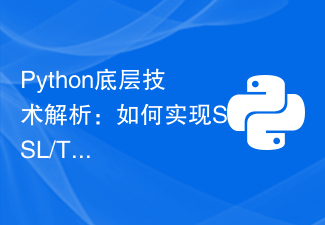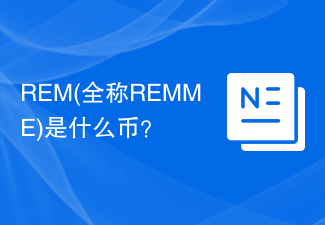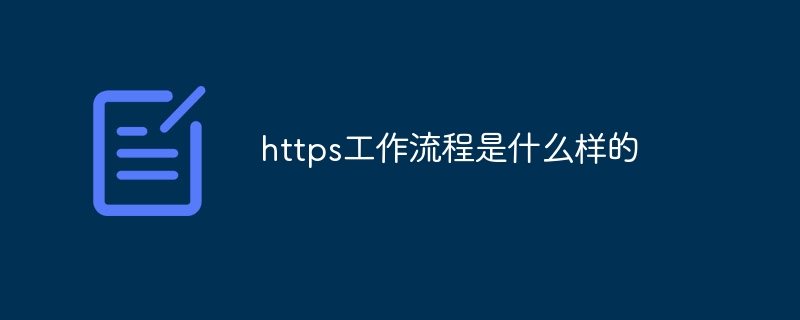
php editor Apple takes you to explore the mysterious world of Java RESTful API, allowing you to become a highly skilled "ninja" in the field of web development. RESTful API is a design style that helps developers build flexible, scalable, and easy-to-maintain web services. This article will deeply analyze the concepts, principles and practical skills of RESTful API, help you master the key skills of using RESTful API for web development in Java, and help you become a top expert in the field of web development!
- Unified Interface: All interactions occur through a unified interface, regardless of the protocol or data format used.
- Stateless: The server does not store any state related to the request.
- Cacheability: Responses may be cached to improve performance.
- Tiers on demand: Applications can be organized into tiers as needed to increase scalability.
Using Java framework Java provides powerful frameworks for developing RESTful APIs, such as JAX-RS, spring mvc and Dropwizard. These frameworks simplify the creation of APIs, providing support for common features such as Http request handling, data binding, and validation. Choose a framework that's right for your project and learn more about its features.
Design Resources and HTTP Verbs
RESTful APIs are organized around resources. Identify resources in your application and assign appropriate HTTP verbs. For example, use GET to get a resource, POST to create a resource, PUT to update a resource, and DELETE to delete a resource. Follow standard conventions between resources and HTTP verbs to ensure API consistency and predictability.
Processing data format RESTful APIs typically use data formats such as JSON or XML to transmit data. Choose the format that suits your application and use an appropriate library or framework to handle data conversion. Make sure your API handles data types, serialization, and deserialization correctly.
Implementing error handling A robust RESTful API should handle errors gracefully. Well-defined error codes and messages to help clients understand the error and take appropriate action. Use exception handling mechanisms to catch and handle errors in your application and return error responses to the client in a meaningful way.
Safety considerations Protecting your RESTful API from unauthorized access and attacks is critical. Implement authentication and authorization mechanisms such as Jwt or OAuth 2.0. Encrypt communications using https and TLS, and regularly audit your code for potential vulnerabilities.
Documentation and Testing Writing comprehensive documentation is critical to the understandability and maintainability of your API. Use tools such as swagger or OpenAPI to generate API documentation detailing endpoints, parameters, and responses. Additionally, test your API with unit tests and integration tests to ensure its correctness and robustness.
Advanced skills As you gain a deeper understanding of the Java RESTful API, explore some advanced techniques to enhance your applications:
- Paging and Sorting: Enables clients to control the amount of data retrieved from the API by supporting paging and sorting functionality.
- Filtering and Searching: Allows clients to filter and search data based on specific criteria to increase the flexibility of the API.
- Versioning: Implement versioning of the API to make changes and add new features over time while avoiding breaking existing clients.
- HATEOAS (Hypermedia as Application State Engine): Use HATEOAS principles to include links in the response that guide the client to discover other endpoints and operations available in the API.
in conclusion Mastering the mysteries of Java RESTful APIs is a step-by-step process that requires a deep understanding of REST principles, Java frameworks, and best practices. By following these guides and exploring advanced techniques, you can become a web development ninja and build stunning RESTful APIs that provide a solid foundation for your applications.
The above is the detailed content of Master the Secrets of Java RESTful APIs: Become a Web Development Ninja. For more information, please follow other related articles on the PHP Chinese website!
 深入探讨HTTP状态码525的定义和特性Feb 19, 2024 am 09:28 AM
深入探讨HTTP状态码525的定义和特性Feb 19, 2024 am 09:28 AM深入解析HTTP状态码525的含义和特点HTTP状态码是HTTP协议中用于表示请求是否成功、失败以及各种错误原因的标识码。其中,状态码525是HTTP/2协议中新增的一种状态码,它表示SSL握手失败。在正常的HTTPS连接中,客户端(浏览器)和服务器之间需要进行SSL握手过程,以确保通信的安全性。SSL握手包括客户端发送ClientHello、服务器回应S
 Python底层技术解析:如何实现SSL/TLS加密通信Nov 08, 2023 pm 03:14 PM
Python底层技术解析:如何实现SSL/TLS加密通信Nov 08, 2023 pm 03:14 PMPython底层技术解析:如何实现SSL/TLS加密通信,需要具体代码示例SSL(SecureSocketsLayer)和TLS(TransportLayerSecurity)是一种用于在计算机网络上实现安全通信的协议。在网络通信过程中,SSL/TLS可以提供加密、身份验证和数据完整性保护等功能,确保数据在传输过程中不会被窃听、篡改或伪造。Pytho
 CentOS 7.9 安装及centos 7.9 安装sshFeb 13, 2024 pm 10:30 PM
CentOS 7.9 安装及centos 7.9 安装sshFeb 13, 2024 pm 10:30 PM在进行服务器搭建或者系统管理时,CentOS7.9是一个非常常用的操作系统版本,本文将为您提供关于CentOS7.9安装以及安装SSH的详细步骤和说明。CentOS7.9是一个免费且开源的Linux操作系统,它是基于RedHatEnterpriseLinux(RHEL)的二进制兼容版本,下面是CentOS7.9安装的步骤:1.您需要下载CentOS7.9的ISO镜像文件,您可以从CentOS官方网站上下载最新的CentOS7.9ISO镜像文件。2.在您的计算机上创建一个新的虚拟机或者物理机,并将
 2024最佳Linux版:科技艺术完美融合,开放创新生活态度Apr 03, 2024 am 08:01 AM
2024最佳Linux版:科技艺术完美融合,开放创新生活态度Apr 03, 2024 am 08:01 AM身为2024年的一位Linux热衷者,我对最佳Linux发行版的期待令人兴奋不已。以下,我将阐述个人观点并解析为何2024年最具魅力的Linux发行版具有独特的诸多优点。1.初识Linux最美发行版毫无疑问,2024年的Linux最优发行版堪称科技与艺术的完美融合。其在用户界面、功能规划以及性能优化等多方面表现卓越,使得面对众多竞争对手也能独树一帜。这不仅是一款操作系统,更象征着自由、开放与创新的生活态度。此最优版本融入了全新设计与互动模式,势必令人耳目一新。无论是布局结构、标识图案或色彩搭配,
 C++ 函数在网络编程中如何实现网络安全?Apr 28, 2024 am 09:06 AM
C++ 函数在网络编程中如何实现网络安全?Apr 28, 2024 am 09:06 AMC++函数在网络编程中可实现网络安全,方法包括:1.使用加密算法(openssl)加密通信;2.使用数字签名(cryptopp)验证数据完整性和发送方身份;3.防御跨站脚本攻击(htmlcxx)过滤和消毒用户输入。
 REM(全称REMME)是什么币?Feb 21, 2024 pm 05:00 PM
REM(全称REMME)是什么币?Feb 21, 2024 pm 05:00 PMREMME是什么币?REMME是一个基于区块链技术的加密货币,致力于提供高度安全且去中心化的网络安全和身份验证解决方案。该项目旨在利用分布式加密技术来增强和简化用户身份验证流程,从而提升安全性和效率。REMME的创新之处在于其借助区块链的不可篡改性和透明性,为用户提供了更可靠的身份验证方式。通过将身份验证信息存储在区块链上,REMME消除了中心化身份验证系统的单点故障,并降低了数据被盗或篡改的风险。这种基于区块链的身份验证方法不仅更安全可靠,而且还能够为用户REMME的背景在当前数字化时代,网络
 https工作流程是什么样的Apr 07, 2024 am 09:27 AM
https工作流程是什么样的Apr 07, 2024 am 09:27 AMhttps工作流程包括客户端发起请求、服务器响应、SSL/TLS握手、数据传输和客户端渲染等步骤,通过这些步骤可以确保数据在传输过程中的安全性和完整性。
 如何使用HTTP代理在PHP中进行加密通信Jun 21, 2023 pm 05:20 PM
如何使用HTTP代理在PHP中进行加密通信Jun 21, 2023 pm 05:20 PMHTTP代理是一种常见的网络通信方式,可以帮助我们实现加密通信。在PHP中,我们可以利用HTTP代理来加密通信,使数据传输更加安全可靠。本文将介绍如何使用HTTP代理在PHP中进行加密通信。一、什么是HTTP代理HTTP代理是一种通过代理服务器进行HTTP请求和响应的方式。在HTTP代理的使用过程中,客户端发送HTTP请求到代理服务器,代理服务器再将请求转发


Hot AI Tools

Undresser.AI Undress
AI-powered app for creating realistic nude photos

AI Clothes Remover
Online AI tool for removing clothes from photos.

Undress AI Tool
Undress images for free

Clothoff.io
AI clothes remover

AI Hentai Generator
Generate AI Hentai for free.

Hot Article

Hot Tools

Dreamweaver CS6
Visual web development tools

DVWA
Damn Vulnerable Web App (DVWA) is a PHP/MySQL web application that is very vulnerable. Its main goals are to be an aid for security professionals to test their skills and tools in a legal environment, to help web developers better understand the process of securing web applications, and to help teachers/students teach/learn in a classroom environment Web application security. The goal of DVWA is to practice some of the most common web vulnerabilities through a simple and straightforward interface, with varying degrees of difficulty. Please note that this software

WebStorm Mac version
Useful JavaScript development tools

Atom editor mac version download
The most popular open source editor

MinGW - Minimalist GNU for Windows
This project is in the process of being migrated to osdn.net/projects/mingw, you can continue to follow us there. MinGW: A native Windows port of the GNU Compiler Collection (GCC), freely distributable import libraries and header files for building native Windows applications; includes extensions to the MSVC runtime to support C99 functionality. All MinGW software can run on 64-bit Windows platforms.






